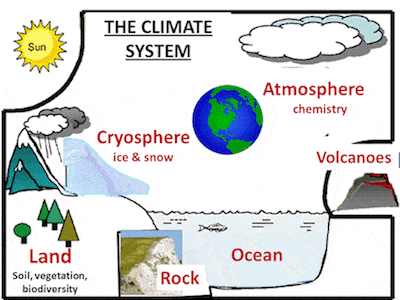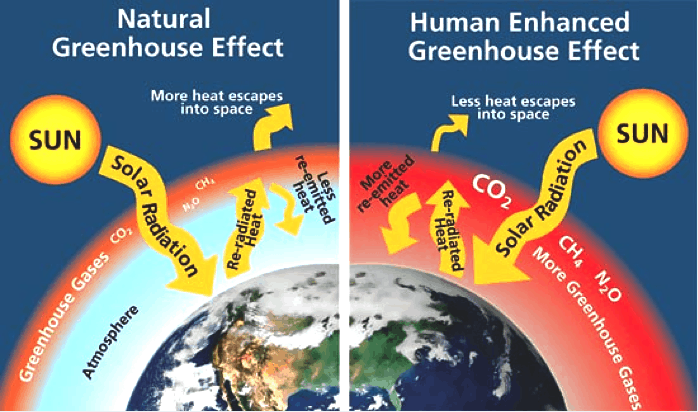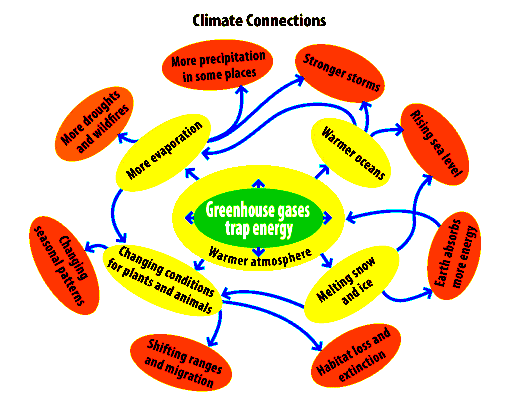Nature and Enviroment
Our Environment
Our environment is everything that surrounds us- from the trees, mountains, roads, buildings, things and even people. It is a combination of both natural and human-made elements. These elements are divided into two types: Biotic and Abiotic. Biotic elements are all the living organisms. Abiotic elements include all the non-living things.

(Source: socratic.org)
Natural Environment
Everything that is not human-made comes under natural environment. Land, air, water, plants and animals all comprise the natural environment. Let us learn about the different domains of the natural environment. These are the lithosphere, hydrosphere, atmosphere and biosphere.

- The lithosphere is the solid crust or the hard top layer of the earth. It is made up of rocks and minerals and covered with a thin layer of soil. The lithosphere is an irregular surface with mountains, plateaus, plains, valleys, landforms, etc. It is the domain that provides us with forests, grasslands for grazing, land for agriculture and housing. It is also a source of minerals.
- Hydrosphere is the domain of water. It comprises of the various sources of water and different types of water bodies like rivers, lakes, seas, oceans, estuaries, etc. It is essential for all living organisms.
- The atmosphere is the thin layer of air that surrounds the earth. It is held by the gravitational force of the earth. The Atmosphere protects us from the harmful UV rays from the sun by blocking them out. It contains a number of gases like oxygen, which is essential for life, dust and water vapour. Changes in atmosphere bring changes in weather and climate.
- All life makes up the biosphere. It is the zone of the earth where land, water and air interact with each other to support life.
Ecosystem
What is an ecosystem? All plants, animals and human beings depend on each other. The relation between living organisms, as well as the relation between living organisms and their environment, form an ecosystem. An ocean is an example of an ecosystem because it comprises of living organisms, land, air ( in dissolved form) and water of course.

Human Environment
Human environment is the man-made environment. It has been modified by humans according to their needs. Before technology evolved, human beings would adapt themselves to the natural environment. They led a simple life and fulfilled their requirements from the nature around them. With time, their needs grew and became more varied. Human learnt new ways to change their environment according to their needs.

They learnt to grow crops, domesticate animals and build houses. They invented the wheel, barter system, trade and commerce. Transportation became faster. Large-scale production was possible through Industrial revolution. Communication became easier and speedy across the world. They have formed an artificial ecosystem.
A perfect balance is necessary between the natural and man-made environment. If we use the sources provided by environment wisely, we can establish a healthy balance. We should use our resources wisely and learn to conserve them. natural resources like wood, minerals, water, air are precious and essential for survival. If we do not use them wisely, we may run out of them one day. We should think about our future generations.
What is Climate Change?
Climate change refers to significant, long-term changes in the global climate.
The global climate is the connected system of sun, earth and oceans, wind, rain and snow, forests, deserts and savannas, and everything people do, too. The climate of a place, say New York, can be described as its rainfall, changing temperatures during the year and so on.
But the global climate is more than the “average” of the climates of specific places.The Climate SystemA description of the global climate includes how, for example, the rising temperature of the Pacific feeds typhoons which blow harder, drop more rain and cause more damage, but also shifts global ocean currents that melt Antarctica ice which slowly makes sea level rise until New York will be under water.
It is this systemic connectedness that makes global climate change so important and so complicated. (Source: US Environmental Protection Agency)
What is Global Warming?Global warming is the slow increase in the average tempera ture of the earth’s atmosphere because an increased amount of the energy (heat) striking the earth from the sun is being trapped in the atmosphere and not radiated out into space.
The earth’s atmosphere has always acted like a greenhouse to capture the sun’s heat, ensuring that the earth has enjoyed temperatures that permitted the emergence of life forms as we know them, including humans.
Without our atmospheric greenhouse the earth would be very cold. Global warming, however, is the equivalent of a greenhouse with high efficiency reflective glass installed the wrong way around.
Ionically, the best evidence of this may come from a terrible cooling event that took place some 1,500 years ago. Two massive volcanic eruptions, one year after another placed so much black dust into the upper atmosphere that little sunlight could penetrate. Temperatures plummeted. Crops failed. People died of starvation and the Black Death started its march. As the dust slowly fell to earth, the sun was again able to warn the world and life returned to normal.
Today, we have the opposite problem. Today, the problem is not that too little sun warmth is reaching the earth, but that too much is being trapped in our atmosphere.
So much heat is being kept inside greenhouse earth that the temperature of the earth is going up faster than at any previous time in history. NASA provides an excellent course module on the science of global warming.How Does Global Warming Drive Climate Change?Heat is energy and when you add energy to any system changes occur.
Because all systems in the global climate system are connected, adding heat energy causes the global climate as a whole to change.
Much of the world is covered with ocean which heats up. When the ocean heats up, more water evaporates into clouds.
Where storms like hurricanes and typhoons are forming, the result is more energy-intensive storms. A warmer atmosphere makes glaciers and mountain snow packs, the Polar ice cap, and the great ice shield jutting off of Antarctica melt raising sea levels. (Source: US Environmental Protection Agency)
Changes in temperature change the great patterns of wind that bring the monsoons in Asia and rain and snow around the world, making drought and unpredictable weather more common.
This is why scientists have stopped focusing just on global warming and now focus on the larger topic of climate change.What Causes Global Warming?There are three positions on global warming: (1) that global warming is not occurring and so neither is climate change; (2) that global warming and climate change are occurring, but these are natural, cyclic events unrelated to human activity; and (3) that global warming is occurring as a result primarily of human activity and so climate change is also the result of human activity.
The claim that nothing is happening is very hard to defend in the face or masses of visual, land-based and satellite data that clearly shows rising average sea and land temperatures and shrinking ice masses.
The claim that the observed global warming is natural or at least not the result of human carbon emissions (see Climate Skeptics below) focuses on data that shows that world temperatures and atmospheric CO2 levels have been equally high or higher in the past. They also point to the well understood effects of solar activity on the amount of radiation striking the earth and the fact that in recent times the sun has been particularly activists' have concluded, is what is heating our earth which causes global warming.
The global climate is the connected system of sun, earth and oceans, wind, rain and snow, forests, deserts and savannas, and everything people do, too. The climate of a place, say New York, can be described as its rainfall, changing temperatures during the year and so on.
But the global climate is more than the “average” of the climates of specific places.
The Climate System A description of the global climate includes how, for example, the rising temperature of the Pacific feeds typhoons which blow harder, drop more rain and cause more damage, but also shifts global ocean currents that melt Antarctica ice which slowly makes sea level rise until New York will be under water. It is this systemic connectedness that makes global climate change so important and so complicated. | (Source: US Environmental Protection Agency) |
The earth’s atmosphere has always acted like a greenhouse to capture the sun’s heat, ensuring that the earth has enjoyed temperatures that permitted the emergence of life forms as we know them, including humans.
Without our atmospheric greenhouse the earth would be very cold. Global warming, however, is the equivalent of a greenhouse with high efficiency reflective glass installed the wrong way around.
Ionically, the best evidence of this may come from a terrible cooling event that took place some 1,500 years ago. Two massive volcanic eruptions, one year after another placed so much black dust into the upper atmosphere that little sunlight could penetrate. Temperatures plummeted. Crops failed. People died of starvation and the Black Death started its march. As the dust slowly fell to earth, the sun was again able to warn the world and life returned to normal.
Today, we have the opposite problem. Today, the problem is not that too little sun warmth is reaching the earth, but that too much is being trapped in our atmosphere.
So much heat is being kept inside greenhouse earth that the temperature of the earth is going up faster than at any previous time in history. NASA provides an excellent course module on the science of global warming.
Heat is energy and when you add energy to any system changes occur. Because all systems in the global climate system are connected, adding heat energy causes the global climate as a whole to change. Much of the world is covered with ocean which heats up. When the ocean heats up, more water evaporates into clouds. Where storms like hurricanes and typhoons are forming, the result is more energy-intensive storms. A warmer atmosphere makes glaciers and mountain snow packs, the Polar ice cap, and the great ice shield jutting off of Antarctica melt raising sea levels. | (Source: US Environmental Protection Agency) |
This is why scientists have stopped focusing just on global warming and now focus on the larger topic of climate change.
The claim that nothing is happening is very hard to defend in the face or masses of visual, land-based and satellite data that clearly shows rising average sea and land temperatures and shrinking ice masses.
The claim that the observed global warming is natural or at least not the result of human carbon emissions (see Climate Skeptics below) focuses on data that shows that world temperatures and atmospheric CO2 levels have been equally high or higher in the past. They also point to the well understood effects of solar activity on the amount of radiation striking the earth and the fact that in recent times the sun has been particularly activists' have concluded, is what is heating our earth which causes global warming.



Comments
Post a Comment